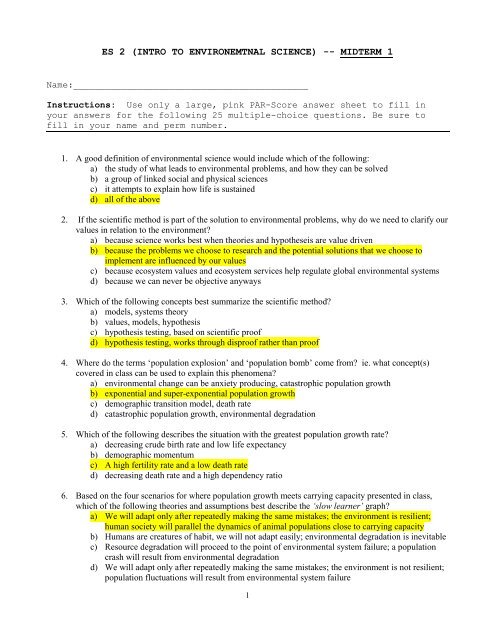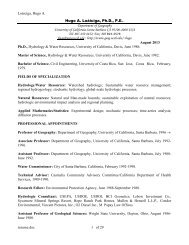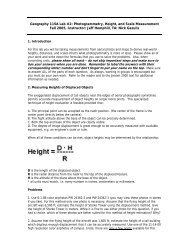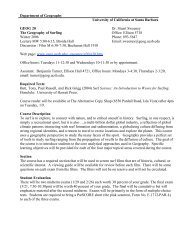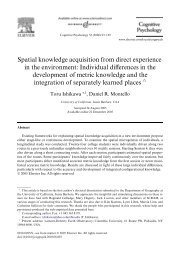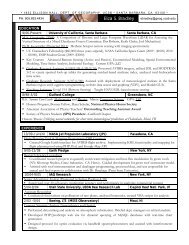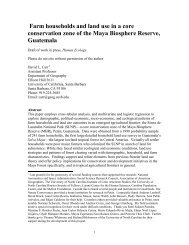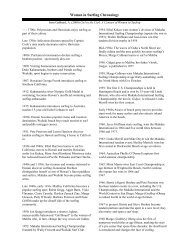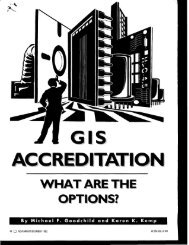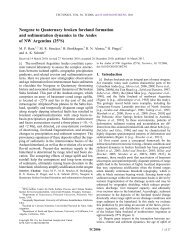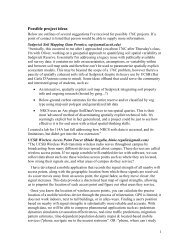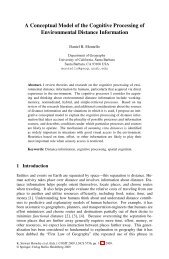ES 2 (INTRO TO ENVIRONEMTNAL SCIENCE) -- MIDTERM 1
ES 2 (INTRO TO ENVIRONEMTNAL SCIENCE) -- MIDTERM 1
ES 2 (INTRO TO ENVIRONEMTNAL SCIENCE) -- MIDTERM 1
You also want an ePaper? Increase the reach of your titles
YUMPU automatically turns print PDFs into web optimized ePapers that Google loves.
<strong>ES</strong> 2 (<strong>INTRO</strong> <strong>TO</strong> <strong>ENVIRONEMTNAL</strong> <strong>SCIENCE</strong>) -- <strong>MIDTERM</strong> 1<br />
Name:____________________________________________<br />
Instructions: Use only a large, pink PAR-Score answer sheet to fill in<br />
your answers for the following 25 multiple-choice questions. Be sure to<br />
fill in your name and perm number.<br />
1. A good definition of environmental science would include which of the following:<br />
a) the study of what leads to environmental problems, and how they can be solved<br />
b) a group of linked social and physical sciences<br />
c) it attempts to explain how life is sustained<br />
d) all of the above<br />
2. If the scientific method is part of the solution to environmental problems, why do we need to clarify our<br />
values in relation to the environment?<br />
a) because science works best when theories and hypotheseis are value driven<br />
b) because the problems we choose to research and the potential solutions that we choose to<br />
implement are influenced by our values<br />
c) because ecosystem values and ecosystem services help regulate global environmental systems<br />
d) because we can never be objective anyways<br />
3. Which of the following concepts best summarize the scientific method?<br />
a) models, systems theory<br />
b) values, models, hypothesis<br />
c) hypothesis testing, based on scientific proof<br />
d) hypothesis testing, works through disproof rather than proof<br />
4. Where do the terms „population explosion‟ and „population bomb‟ come from? ie. what concept(s)<br />
covered in class can be used to explain this phenomena?<br />
a) environmental change can be anxiety producing, catastrophic population growth<br />
b) exponential and super-exponential population growth<br />
c) demographic transition model, death rate<br />
d) catastrophic population growth, environmental degradation<br />
5. Which of the following describes the situation with the greatest population growth rate?<br />
a) decreasing crude birth rate and low life expectancy<br />
b) demographic momentum<br />
c) A high fertility rate and a low death rate<br />
d) decreasing death rate and a high dependency ratio<br />
6. Based on the four scenarios for where population growth meets carrying capacity presented in class,<br />
which of the following theories and assumptions best describe the ‘slow learner’ graph?<br />
a) We will adapt only after repeatedly making the same mistakes; the environment is resilient;<br />
human society will parallel the dynamics of animal populations close to carrying capacity<br />
b) Humans are creatures of habit, we will not adapt easily; environmental degradation is inevitable<br />
c) Resource degradation will proceed to the point of environmental system failure; a population<br />
crash will result from environmental degradation<br />
d) We will adapt only after repeatedly making the same mistakes; the environment is not resilient;<br />
population fluctuations will result from environmental system failure<br />
1
7. Based on the four scenarios for where population growth meets carrying capacity presented in class,<br />
which of the following theories and assumptions best describe the ‘neo-malthusian’ graph?<br />
a) Humans have the capacity to adapt to environmental change; nature is not resilient and will<br />
„crash‟ if degraded; population crash will result from environmental degradation<br />
b) Humans do not have the capacity to adapt to environmental change; resource degradation will<br />
proceed to the point of environmental system failure; a population crash will result from<br />
environmental degradation<br />
c) Environmental restoration is possible; however, civilization will inevitably crash<br />
d) We will adapt only after repeatedly making the same mistakes; environmental degradation is<br />
inevitable; a population crash is inevitable<br />
8. A columnar shaped population pyramid indicates a country that is<br />
a) growing slowly or not at all<br />
b) growing rapidly<br />
c) experiencing high immigration rates<br />
d) composed mainly of older age classes<br />
9. Country A is in Stage 1 of demographic transition, while country B is in Stage 2. Net migration is equal<br />
in both countries. Which of the following is true about the population growth of these two countries?<br />
a) population growth rate of country A is higher than that of country B<br />
b) population growth rate of country B is higher than that of country A<br />
c) the population of both countries is not changing<br />
d) it depends on the total fertility rates in each country<br />
10. In lecture, we discussed ways in which “population growth is the underlying environmental problem”<br />
can be considered an incomplete statement. Which of the following concepts best summarizes other<br />
factors to include?<br />
a) industrialization, poverty issues, third world development<br />
b) conservation and development, biogeochemical cycling<br />
c) environmental systems, biodiversity, value systems<br />
d) Population distribution, consumption rates, technology<br />
11. Which of the following social and economic factors mediate a population‟s environmental impact?<br />
a) Accessibility<br />
b) Institutions<br />
c) Economic development and urbanization<br />
d) All of the above<br />
12. Which of the following best describes a fundamental Classification of Rocks in the rock cycle?<br />
a) Stratified Rock, Unstratified Rock<br />
b) Granite, Sandstone, Marble<br />
c) Laccolith, Batholith, Plutonic Form<br />
d) Sedimentary Rock, Igneous Rock, Metamorphic Rock<br />
13. What is most likely to happen when a piece of oceanic crust and a piece of continental crust converge?<br />
a) Lateral movement along a transform fault boundary.<br />
b) Subduction of denser oceanic crust under continental crust, and mountain formation due to<br />
folding of the plates.<br />
c) Formation of new plate material, and propagation of the plate tectonic process and the rock<br />
cycle.<br />
d) A linear group of islands paralleling the fault boundary.<br />
2
14. What are the four pathways of biogeochemcial cycling mentioned in lecture?<br />
a) Atmosphere, lithosphere, hydrosphere, biosphere<br />
b) they are in the biosphere and the human sphere<br />
c) Atmosphere, climate, vegetation, biology<br />
d) Biosphere, physical, mediated, change<br />
15. An agricultural system that has been poorly managed for over 30 years now has soils that are nitrogen<br />
depleted, which has led to a decline in crop yields. The low levels of soil nitrogen is an example of:<br />
a) Nitrogen assimilation<br />
b) A geologic factor<br />
c) Nitrogen volatility<br />
d) A limiting factor<br />
16. The carbon cycle is mediated primarily by ___________ processes, whereas the hydrologic cycle is<br />
mediated primarily by __________ processes.<br />
a) biological, physical<br />
b) atmospheric, geologic<br />
c) change, weather<br />
d) human, environmental<br />
17. As discussed in class, algal blooms in lakes and ponds are associated with which of the major<br />
biogeochmeical cycles?<br />
a) The hydrologic cycle<br />
b) The phosphorous cycle<br />
c) The biologic cycle<br />
d) The nitrogen cycle<br />
18. Which of the following describes the fundamental characteristic of ecosystems?<br />
a) structure, function, process, change<br />
b) Openness, structure, functionality<br />
c) Terrestrial, aquatic, geomorphic<br />
d) Energy, biotite, flows<br />
19. A population of 1000 grasshoppers living on the shores of a pond consumes 3,300 kg of grass per year;<br />
this population of grasshoppers supports 20 frogs in the pond. This is an example of:<br />
a) loss of energy as it flows through the ecosystem<br />
b) frogs are the keystone species (or ecosystem regulators) in this system<br />
c) a trophic gain in energy<br />
d) bioaccumulation<br />
20. A forest fire is an example of which of the following:<br />
a) ecosystem disturbance, release of thermal energy<br />
b) thermal flows, vegetation<br />
c) ecosystem disturbance, eolian effect<br />
d) soil stabilization, water erosion<br />
21. How can we differentiate between Net Primary Productivity [------] and Biomass [------]?<br />
a) Surplus energy after plant respiration; plant matter remaining after herbivory<br />
b) Photosynthesis; respiration<br />
c) Energy dissipation; plant growth<br />
d) Photosynthesis and plant respiration; vegetative composition<br />
3
22. Which of the following constitute functions performed by consumer populations?<br />
a) Grazing and herbivory<br />
b) Biodiversity<br />
c) Seed dispersal<br />
d) All of the above<br />
23. What would happen if decomposers were not a major component of ecosystems?<br />
a) The excess CO 2 would increase the rate of global warming<br />
b) The increased organic matter would deplete nutrients from the soil<br />
c) 1 and 2 consumer populations would increase<br />
d) Dead plant material would continue to accumulate indefinitely<br />
24. What is the largest spatial scale at which vegetation types can be classified based on climate?<br />
a) Ecosystem<br />
b) Order<br />
c) Biome<br />
d) Habitat<br />
25. Why is it that vegetation and growth forms can be found in zones that are strikingly similar in both<br />
elevational and latitudinal gradients?<br />
a) Plants are respond to changes in temperature and moisture in a similar manner, even in<br />
geographically distinct areas<br />
b) It is natural for life zones to be segregated<br />
c) The biome is a supracontinental classification system<br />
d) There is no similarity between vegetative growth forms on elevational and latitudinal gradients<br />
4


